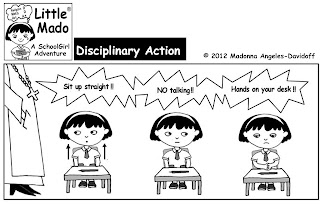
Illustrated by Maria Madonna Davidoff
Little Mado Comic Blog
Today's interview is with Maria Madonna Davidoff, graphic novelist, graphic designer, writer, cartoonist, painter, crafter and blogger who has a degree in Fine Arts (Visual Communications) from the University of Phillipines.
MLAC: You have quite an unusual and very interesting background!
MMD: I was born in the Philippines but have lived in Switzerland, Singapore and the USA. I am now based in New Jersey. I come from a family of writers. My grandfather (Juan L. Arsciwals) was ahead of his time because he was profeminist. He wrote books about women...not in the way they were perceived at that time. My mother, Luzviminda Arsciwals, was a screenwriter for a popular TV Series, and a journalist for a Phillipine newspaper called Taliba. She wrote in Tagalog Language which is the National Language of the Phillipines. My brother, Jolan Angeles, is a playwright who won a major award for a screenplay entitled "Kastilyo ni Kardo". My father was an architect turned businessman. All of my life I've been working as an illustrator/graphic designer for several publishers and have been influenced in a visual sense. I got the visual from my dad and my interest in the literary from my mother.
MLAC: What was the onset of your career?
MMD: Right after I graduated from the University of the Phillipines, my family and I moved to New York. So, my professional life started in America. My first illustration job was with Crane Publishing in New Jersey and my assignment was for a 4th grade reader in full color. I've done lots of graphic design work and illustrations for magazines, newspaper, graphic studios, catalogs, retail catalogs, publishing houses and textbooks.
MLAC: Describe your cartoon strip...Little Mado.
MMD: My cartoon character Little Mado (short for Madonna) attends a Private Catholic School for all girls run by American Nuns ( Maryknoll Sisters). The medium of instruction there is English. It's really like a fictional memoir because I want to use my imagination. I attended an all girl Catholic School from 1st grade through High School. I want to use the environment, atmosphere and the interaction among classmates. I'm compiling all the cartoons into a sequential graphic novel. Little Mado's experiences take place within the school and outside of the school.
MLAC: Any other inspiration or influences for the Little Mado Cartoon?
MMD: Social media played a big part in this. I had a lot of friends that I found through Facebook. When I started to post some of the Little Mado Comic Strip, I got a lot of comments from my former classmates who inspired me to develop it further into a graphic novel. These classmates are from Switzerland, NY, Phillipines, Canada, Australia, etc. and have made comments about their own experiences also. So, I dedicated the graphic novel to my classmates (school girls) from Maryknoll.
MLAC: Can you tell us a bit about your latest projects?
MMD: The Little Mado Graphic Novel is just one aspect of my work. I am finishing the illustrations for a nonfiction book I've written about homes around the world called At Home Around The World. I was inspired by living in different countries around the world. This Pre K book depicts children of different cultures and what they do in their homes. Another project I am currently involved with ..."The Crafty Madonna Items". I have created International Plush Dolls, Postcards and Paintings and sell them on my website. I also exhibit Batik Paintings that I completed in Bali Indonesia and are displayed at the Yippie Museum in NYC.
MLAC: What type of materials do you use?
MMD: I use a combination of digital and conventional materials. I can work in wash and water color. I scan them and rework them digitally. It's easier to revise them. I start with a pencil sketch, then I scan them and rework them. I use a Wacom Tablet to draw directly on my computer.
View Some of Maria Madonna's Latest Projects:Maria Madonna's Comic Strip Little Mado is featured weekly at the online magazine OSM!
(The online magazine for awesome global citizens):
http://justcliqit.com/little-mado
Maria Madonna’s Online Craft store “Crafty Madonna”showcases her handmade Plush Dolls representing different countries, Postcards and her Original Small Canvas Paintings:
http://mariamadonnadavidoffsblog.blogspot.com/2009/08/launching-of-my-online-store-at-etsy.html
Maria Madonna originates from a family of writers starting with her maternal grandfather,
Juan Lauro Arsciwals:
Maria Madonna’s website:
Maria Madonna’s Artist Blog:
A New York Times features Maria Madonna together with other artists painting in Central Park, NYC:
An Award from the SCBWI first Art Showcase 2003 in NYC:
Maria Madonna’s Art exhibit appeared last summer at the Yippie Museum in Soho NYC:
http://www.af3irm.org/2012/3/xicana-and-filipina-transnational-women-artists-join-af3irm%E2%80%99s-la-bracera-women-and-work-exhib
Maria Madonna’s latest book published will be launched Spring 2013
http://www.lulu.com/shop/bart-davidoff/momsies-book/paperback/product-15769671.html













